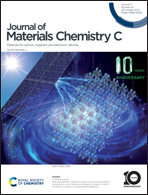Effect of interfacial SiO2 layer thickness on the memory performances in the HfAlOx-based ferroelectric tunnel junction for a neuromorphic system†
Abstract
In recent years, research on ferroelectric materials based on hafnium oxide has increased because of promising advantages such as fast operating speeds and CMOS process compatibility. In the case of Al-doped HfO2 (HAO), the remnant polarization (Pr), switching endurance, and high ON/OFF ratio can induce better ferroelectricity. In this work, three metal–ferroelectric–(insulator)–semiconductor MF(I)S devices with TiN/HAO/n+ Si and 1 nm and 2 nm thick SiO2 insulators inserted between the ferroelectric layer and the semiconductor have been studied. Doping Al2O3 results in enhanced ferroelectric properties such as switching voltage and higher polarization compared to that of undoped HfO2. It is because the stabilization of tetragonal phases results in a high dielectric constant. The MFIS (1 nm) device's high remnant polarization value of 37.8 μC cm−2 was measured using polarization-switching PUND (positive-up–negative-down). Additionally, with DC dual sweeping, I–V characteristics exhibited a wide memory window and a large tunneling electro-resistance (TER) ratio. Furthermore, it has shown improvement in current and energy performance because of the stronger bond between the ferroelectric layer and the bottom electrical material and high charge transfer efficiency. Finally, we have successfully demonstrated the properties of the interfacial SiO2 layer and found the thickness of the optimal interlayer for the MFIS structure. Various experiments were conducted to study the synaptic characteristics of FTJ devices, including the long-term potentiation and depression, paired-pulse facilitation (PPF), spike-timing-dependent plasticity (STDP), and the recognition and prediction ability of the device using reservoir computing (RC) technology. Through these experiments, the fabricated device is suitable as an ideal device for implementing energy-efficient and high-speed artificial neural network applications.

- This article is part of the themed collection: #MyFirstJMCC


 Please wait while we load your content...
Please wait while we load your content...